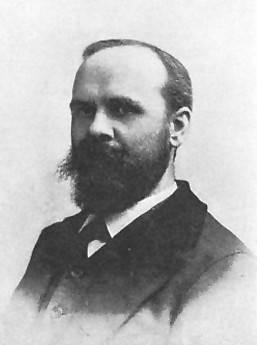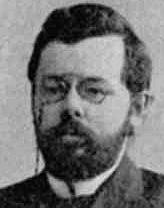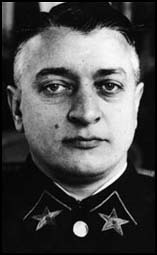Tu
Tucker, Benjamin R. (1854-1939)
 Perhaps the most important of American individualist anarchists, Tucker’s importance lies not only in his voluminous writings, but in his role in disseminating anarchist ideas in the US. From 1881-1908 his review “Liberty” was among the most prominent voices for anarchism. His bookstore and publishing house were vital sources of propaganda until the fire that destroyed his offices in 1908. Finally, Tucker was also the man responsible for having Max Stirner’s “The Ego and His Own” translated into English. He lived the final decades of his life in France.
Perhaps the most important of American individualist anarchists, Tucker’s importance lies not only in his voluminous writings, but in his role in disseminating anarchist ideas in the US. From 1881-1908 his review “Liberty” was among the most prominent voices for anarchism. His bookstore and publishing house were vital sources of propaganda until the fire that destroyed his offices in 1908. Finally, Tucker was also the man responsible for having Max Stirner’s “The Ego and His Own” translated into English. He lived the final decades of his life in France.
See Benjamin R Tucker Archive.
Tugan-Baranovsky, Mikhail (1865-1919)
 Russian Marxist and follower of Bernstein. Later remained a socialist, but rejected Marxism. Wrote well-known works relating to the crisis of capitalism and Russian factories.
Russian Marxist and follower of Bernstein. Later remained a socialist, but rejected Marxism. Wrote well-known works relating to the crisis of capitalism and Russian factories.
Tukhachevsky, Mikhail (1857-1932)
 Mikhail Tukhachevsky was born in Slednevo, Russia, on 4th February, 1893. Lvov, Galicia, in 1885. Born into a noble family, Tukhachevsky graduated from the Alekzanderskoe Military Academy in 1914.
Mikhail Tukhachevsky was born in Slednevo, Russia, on 4th February, 1893. Lvov, Galicia, in 1885. Born into a noble family, Tukhachevsky graduated from the Alekzanderskoe Military Academy in 1914.
Tukhachevsky fought in the Russian Army during the First World War. After the October Revolution he joined the Bolsheviks. Tukhachevsky became an officer in the Red Army and was given responsibility of defending Moscow in 1918.
Leon Trotsky gave Tukhachevsky command of the 5th Army in 1920 and he managed to capture Siberia from Alexander Kolchak. He also helped defeat General Anton Denikin in the Crimea in 1920. Tukhachevsky fought in Poland and helped suppress the Kronstadt Rising in 1921.
Tukhachevsky served as chief of staff (1925-28) and as deputy commissar for defence. He wrote several books on modern warfare and in 1931 was given a leading role in reforming the Red Army.
In 1935 Tukhachevsky was made a marshal of the Soviet Union. However, Joseph Stalin became convinced that the leaders of the Red Army were involved in a plot to overthrow him. In June, 1937, Tukhachevsky and seven other top commanders were arrested and charged with conspiracy with Germany. Mikhail Tukhachevsky was found guilty and executed on 11th June, 1937.
In 1936 Heydrich, chief of Intelligence in Germany, received a visit from a former officer in the Czarist army, General Skoblin. This general without an army was consoling himself for his inactivity by playing double agent on a grand scale. For many years he had been working for Soviet Intelligence on the side.
The news he brought Heydrich was momentous: he had it on good authority that Marshal Tukhachevsky was plotting an armed insurrection against Stalin. Heydrich passed this on to the Nazi high command, who discussed what course to follow. There were only two options: allow the head of the Soviet Army to go ahead with the plan, or warn Stalin and, as a bonus, give him proof of the marshal's collusion with the Wehrmacht. The second solution was chosen.
The most sophisticated apparatus for conveying top-secret orders was at the service of Nazi propaganda and terror. Heydrich had made a study of the Russian OGPU, the Soviet secret security service. He then engineered the Red Army purges carried out by Stalin. The Russian dictator believed his own armed forces were infiltrated by German agents as a consequence of a secret treaty by which the two countries helped each other rearm. Secrecy bred suspicion, which bred more secrecy, until the Soviet Union was so paranoid it became vulnerable to every hint of conspiracy.
Late in 1936, Heydrich had thirty-two documents forged to play on Stalin's sick suspicions and make him decapitate his own armed forces. The Nazi forgeries were incredibly successful. More than half the Russian officer corps, some 35,000 experienced men, were executed or banished.
The Soviet chief of Staff, Marshal Tukhachevsky, was depicted as having been in regular correspondence with German military commanders. All the letters were Nazi forgeries. But Stalin took them as proof that even Tukhachevsky was spying for Germany. It was a most devastating and clever end to the Russo-German military agreement, and it left the Soviet Union in absolutely no condition to fight a major war with Hitler.
See Mikhail Tukachevsky Archive
Turati, Filippo (1857-1932)
 From 1886 Turati was a member of the Partito Operaio Italiano, founded in Milan by Giuseppe Croce. He broke away to form the Milanese Socialist League in 1889, and became concerned to unify the fragmented Italian left around a Marxist platform. With his partner Anna Kuliscioff he founded the journal 'Critica Sociale' which was for many years the main theoretical outlet of the left, and from 1891 they worked to form a unified Italian Socialist Party. Turati was identified with the reformist wing of this party, and sustained a polity of openness and co-operation with Mazzinian and Radical parties. In 1896 he was elected to parliament for the Socialist Party. In 1903 Giolitti offered him to join
the government. Although he wished to accept this proposal, he was compelled
to refuse because of the internal opposition inside the socialist party.
After the end of the First World War, while the party was expressing itself
in favour of a more strict and constant relation with the IC, Turati worked
to regain the dialogue with Giolitti. In 1922 his reformist wing split from
the Socialist Party, giving birth to the Unitarian Socialist Party of Italy
[Partito Socialista Unitario Italiano]. After the party secretary was murdered by fascists in 1925 the party went underground, and Turati himself went into exile. He lived the rest of his life in Paris, where he worked on building up anti-fascist groups and on the reunification of the Socialist Party, which took place in 1930.
From 1886 Turati was a member of the Partito Operaio Italiano, founded in Milan by Giuseppe Croce. He broke away to form the Milanese Socialist League in 1889, and became concerned to unify the fragmented Italian left around a Marxist platform. With his partner Anna Kuliscioff he founded the journal 'Critica Sociale' which was for many years the main theoretical outlet of the left, and from 1891 they worked to form a unified Italian Socialist Party. Turati was identified with the reformist wing of this party, and sustained a polity of openness and co-operation with Mazzinian and Radical parties. In 1896 he was elected to parliament for the Socialist Party. In 1903 Giolitti offered him to join
the government. Although he wished to accept this proposal, he was compelled
to refuse because of the internal opposition inside the socialist party.
After the end of the First World War, while the party was expressing itself
in favour of a more strict and constant relation with the IC, Turati worked
to regain the dialogue with Giolitti. In 1922 his reformist wing split from
the Socialist Party, giving birth to the Unitarian Socialist Party of Italy
[Partito Socialista Unitario Italiano]. After the party secretary was murdered by fascists in 1925 the party went underground, and Turati himself went into exile. He lived the rest of his life in Paris, where he worked on building up anti-fascist groups and on the reunification of the Socialist Party, which took place in 1930.
Turing, Alan (1912-1954)
 English mathematician and logician who pioneered computer science, creating the famous ‘Turing machine’ – the minimal computer. Turing was the first advocate of Artificial Intelligence, arguing that there was nothing human which could not be emulated by a computer, and that consequently computers would eventually ‘be able to think’; his arguments are closely connected to Behaviourism and are at the root of contemporary Complexity Theories of society. Chomsky’s linguistics also have their origins in Turing’s conception of computer language.
English mathematician and logician who pioneered computer science, creating the famous ‘Turing machine’ – the minimal computer. Turing was the first advocate of Artificial Intelligence, arguing that there was nothing human which could not be emulated by a computer, and that consequently computers would eventually ‘be able to think’; his arguments are closely connected to Behaviourism and are at the root of contemporary Complexity Theories of society. Chomsky’s linguistics also have their origins in Turing’s conception of computer language.
Born in India and educated at Cambridge, Turing took his PhD at Princeton before taking up a fellowship at King's College. During World War II he worked with the British Government Code and Cypher School, where he developed brilliant techniques to break the enemy's codes. In 1945 he joined the National Physical Laboratory in London to build a large electronic digital computer. In 1948 he became deputy director of the Computing Laboratory at the University of Manchester, building the computer with the largest memory capacity in the world at that time. His pioneering work on the theory of computer languages was of epoch-making significance.
It was his early work at Princeton however, which has had the most profound affect on the development of philosophy. In 1935, he took on the task of finding an algorithm (i.e. a finite sequence of well-defined steps of reasoning) to find undecidable propositions in a mathematical theory which Gödel had proved, in his 1931 theorem, must exist in every theory; the aim being to eliminate them and restore the theory to completeness and consistency, effectively negating Gödel's theorem.
The surprising result was “On Computable Numbers, with an Application to the Halting Problem” in which Turing described a hypothetical (“Turing”) machine with (1) a finite set of instructions (program), (2) some means of executing the instructions step-by-step (processor), and (3) some readable means for recording each step (memory). This elementary Turing machine was able to execute any algorithm and became the theoretical model for the digital computers that would come into being in the 1940s. The problem Turing had set out to solve was now transformed into the problem of whether or not there was a program, which once initiated, would keep the computer working without ever stopping or getting into a repetitive cycle. The fact that this approach failed to negate Gödel's theorem, verified it in fact, paled next to the significance of the “Turing machine”, but finally put to rest the hopes of David Hilbert and his school that all mathematical propositions could be expressed as a set of axioms and derived theorems.
Turing is also renowned as the first champion of Artificial Intelligence, claiming that computers would eventually be constructed that would be capable of human thought, and he proposed a simple test, now known as the Turing test, to assess this capability. See Computer Machinery & Intelligence [off-site].
In 1952 Turing published the first part of a study of morphogenesis, the development of pattern and form in living organisms, but the work was never finished, as Turing committed suicide, evidently depressed while being forced to undergo medical treatment in lieu of prison to “cure” him of homosexuality.